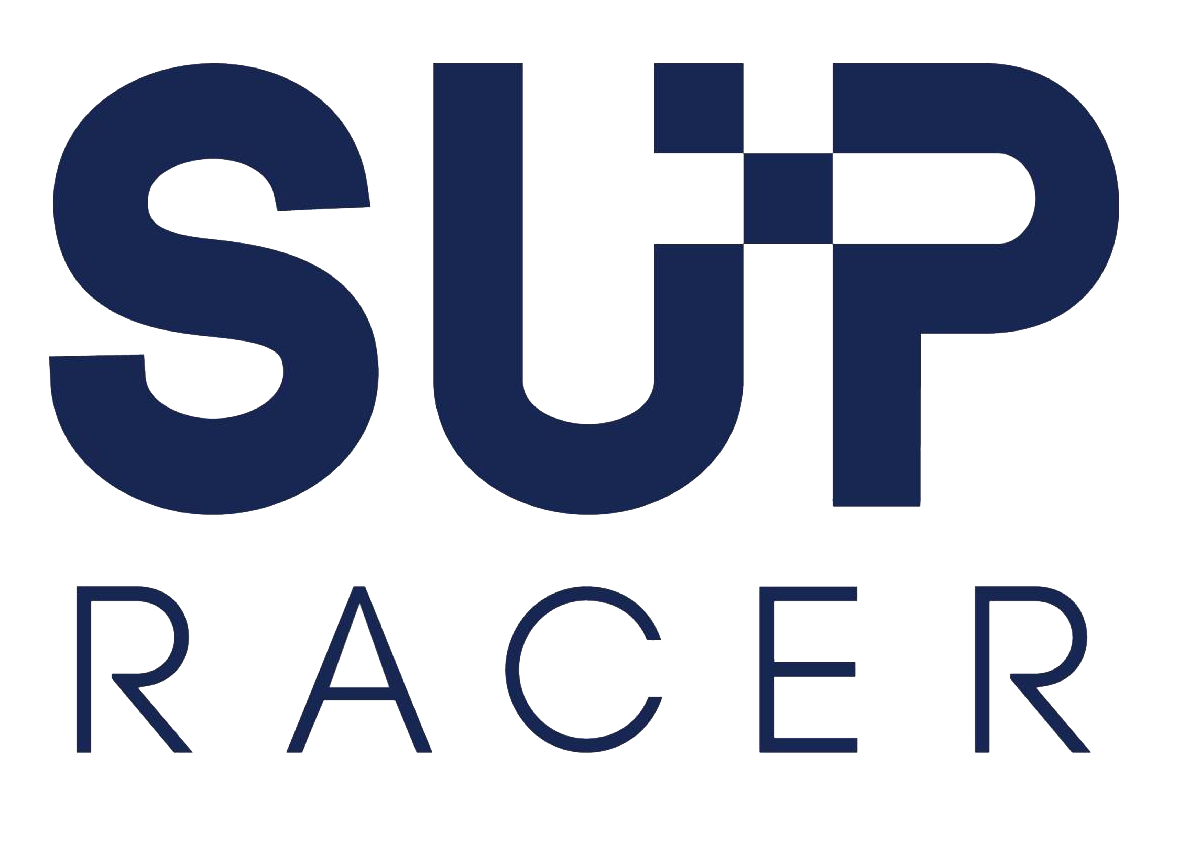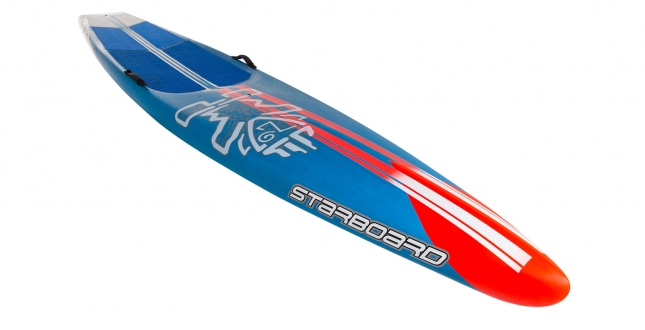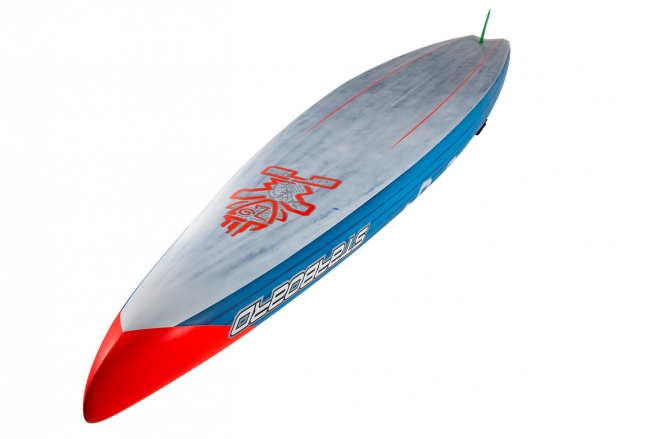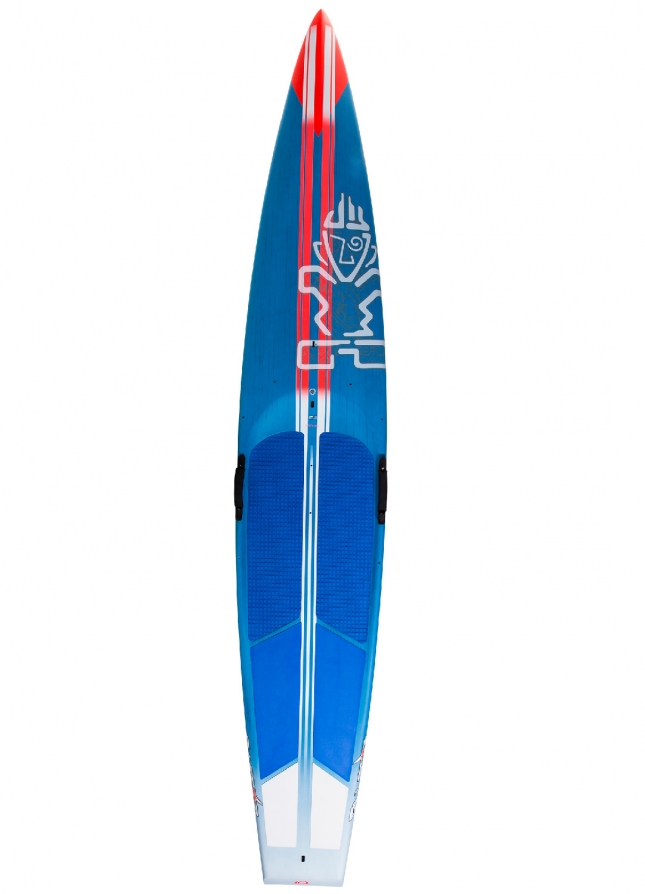
Larry Cain’s Methodical Review of the 2016 Starboard All Star
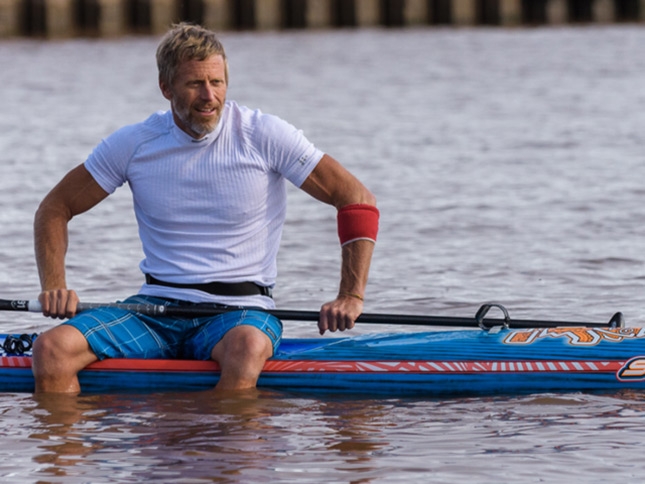
Boss Man’s note: This is a guest post from Larry Cain — 1984 Olympic gold medalist, veteran stand up paddler, champion racer and one of the most respected and methodical teachers of paddling on the planet (as anyone who follows his excellent training blog will know). Larry will be competing at the Carolina Cup next weekend for Team Starboard, and is soon launching the sport’s first specialist online SUP coaching club, Paddle Monster
Review of the 2016 14′ x 25″ Starboard All Star
While in Florida this winter coaching the Canadian Canoe-Kayak Team, I was also piling up as much mileage on the water myself; There was the small matter of the 805km (500 miles) that I’ve been chasing as part of the 100/100 Paddle Challenge, as well as preparation for early season races like the Carolina Cup and the Key West Classic. So finding quality time on the water between coaching sessions was pretty important.
Since I’d be flying into Florida from Toronto I’d arranged with the area Starboard rep, Andrew Crane, to pick up a board at Epic Boardsports in Cocoa Beach. I had no idea what I’d end up paddling on and truthfully wasn’t super picky. I just wanted something that I could train on and use to pile up quality mileage. Imagine my surprise when Jennifer from Epic showed me the board Andrew had left for me – a brand new, 2016 14’ x 25” All Star!
I’d been waiting to really give this board a test since trying Bart de Zwart’s briefly at Chattajack last year. Mine hadn’t arrived yet so this was my first chance to put the new All Star through its paces.
After two weeks and 238km (148 miles) paddling in a variety of conditions, I’ve come to know this board pretty well. My opinion? It’s outstanding!
First of all, I think the board is beautiful. It’s got an awesome shape and finish, cool-looking stripe pattern, and I like the red nose and the white, off-center Tiki man. They’ve paid attention to little details, like recessing the deck pad so the front of it is flush with the board in case you ever need to stand forward of it. It has the same selection of handle options as the 2015 All Star. The bottom is whitish-blue brushed carbon, which helps keep the board cooler when it has to be left out in the sun. Just flip it over and it’s not going to cook on you.
The board is light. Just like what we’re used to from the Starboard Carbon Sandwich range of boards. I didn’t have the opportunity to drop it on a scale but I’d guess it’s right around 24lbs (10.8kgs) or just under. Yet its construction is really solid. It’s rock hard – there are no soft spots anywhere. The funky triple concavities on the bottom, beyond serving to make this board perform like no other, look cool and the curves on the top of the board, from the high volume nose and front end, to the recessed deck are aesthetically pleasing as well. It’s an exciting looking board.
But all that would grow old quickly if this board didn’t perform. Fortunately, this board’s performance is remarkable. Here’s what I discovered in two super fun weeks with it:
- Stability – This stand up paddle board is incredibly stable. Definitely more stable than last year’s model and that board’s stability was very good. On the new All Star you’re a little lower to the water than on the 2015 as the deck is slightly more recessed, and I think the concavities and really sharp rails help to make it more stable also. This stability means you have tremendous confidence on it. I let some of the locals who paddle on wider boards try it and they had the same impression. It feels stable like a 30” recreational SUP. No joke. But it sure doesn’t perform like one…
- Flat-water speed – Without running any quantitative testing and going only by impressions and real time feedback from my GPS, I’d say this board is extremely fast in flat water. There have been some internet posts I’ve seen recently that suggest that the 2015 is slightly faster in flat water, and I’ve heard lots of people speculate that the nose shape of the 2016 All Star, while leading to improved performance in chop and downwind paddling, compromises the board’s performance in the flats. Although I haven’t had the opportunity to do my own tests comparing the two boards head-to-head (that’s coming in April), my impression after two weeks of paddling the new board is quite different. I wouldn’t be surprised if it is actually faster.
The nose shape of the 2016 All Star makes it a noisier ride than the 2015 version. I have to admit, one of the things I love about the 2015 board is that it’s a quiet ride. It feels almost like a racing canoe the way it cuts the water and rides over it. I tested a lot of different boards last June before settling on the All Star, and I can tell you that it was one of the few boards I tried where I didn’t feel like I was pushing water out of the way at the nose. That, and the buoyancy created by the extra volume the 2015 All Star had over most other boards in its class, helped make it substantially faster in all the testing I did.
The 2016 All Star harkens back to the days of the grey 2013 boards and the “whiskers” of water that would come off the nose when paddling. The 2016 All Star doesn’t spray water as much as the older generation boards, but it does spray some, and certainly isn’t the quiet ride that the 2015 board is. I think this gives some the impression that it’s slower in the flats. I didn’t find that, however.
The first thing you notice other than the stability when you step on this board is the buoyancy. The thing feels extremely “floaty”. Here’s a photo, courtesy of Ron Jones, of me just after I hopped on it for the first time. The board hardly sinks into the water at all when asked to handle my 185 lbs. I found this allowed me to get the board up out of the water exceptionally easily. It gets on top of the water more easily than the 2015 for sure. All I had to do is lean on the paddle and I had the impression that the board was on top of the water and skimming over it. In almost any craft I’ve ever paddled this equals speed.
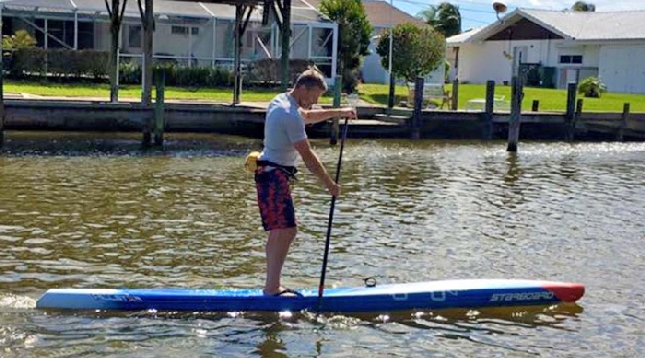 [notdevice] [/notdevice]
[notdevice] [/notdevice]
While I could get the board to accelerate really well, I was most impressed by it’s ability to sustain speed. Lets be clear. All the tests that people do that measure a board’s “speed” by just looking at the top speed they can make it reach in a sprint are pretty much worthless if we’re looking for a board that is going to be fast in distance races. I’m interested in a board that is going to be good in races like the Carolina Cup, which is about 13 miles. So I need to consider what travelling speed a board can maintain and how easy it is to maintain it.
I could get the 2016 All Star to travel at a really fast pace for sustained periods of time fairly easily. My impression is that its ability to be fast over a long distance is excellent. The 2015 All Star was good at this as well, but the new board feels like it’s even better and I’ll test the two head-to-head for this in April. For that matter the 2016 All Star’s acceleration to top speed feels really good as well. I’ll also test its speed “out of the hole” to top speed and compare it to the 2015.
One thing I always do when testing boards is play around with where I’m standing and look to my GPS for real time feedback on speed. I found that this board seems to be fastest if I stand a little in front of the handle. In fact, with my slightly offset stance the big toe of my leading foot was actually just off the front of the deck pad. This sets the nose a little deeper and gets all 14 feet of board in the water. I suspect that a lot of people who have tested this board to date may have been standing too far back. In my April testing I’ll get quantitative information about speed in various positions on the board and share the results.
- Flat-water upwind – One would think that a really buoyant SUP race board with lots of volume that sits high in the water might be somewhat ineffective in a headwind. I didn’t find this at all. In fact my GPS readings and the load in my muscles told me that this board is a great board for flat-water head wind paddling.
- Flat-water in a tailwind – I was impressed with the board’s performance in this condition more than any other flat-water condition. I found this board to be a rocket in a tailwind. I think that fact that it is so buoyant, gets out of the water so easily and stays on top so well makes it super fast in a tailwind. It reminded me of my favorite two man racing canoe, the Cheetah, which was a fat, ugly thing as racing canoes go but even today, 30 years later, stacks up as fast in a tailwind against any of the narrower modern designs.
There was one day that I coached the 200m men’s kayak team from my board as they were doing short sprints and I had lots of time to catch up to them in their rest. When we were paddling back to the dock after the workout there was a section of water with a really strong tailwind and small chop. The kayak guys were staggered at how fast I could go and how well I could keep up to them in that condition. I had no problem maintaining travelling speeds in the 10.9 to 11.3 km/h range which is 6.78 to 7.00 mph for sustained periods of time and I’ve included a couple of videos in which I am doing an exaggerated power stroke rather than a sprint and am still hitting just over 12 km/h or 7.46 mph for shorter pieces.
[notdevice]
- Side wind – In flat-water side wind conditions where there are just little ripples this board tracks awesomely well, making the side wind a total non-factor. One might assume that a board with such a high volume front half would catch the wind and be difficult to steer in a side wind. This is definitely not the case.
- Tracking – This race board runs like it is on rails. I just used the stock fin that comes with the board and it tracked as well as the 2015 All Star, which is about the best tracking board I’ve ridden. Yet if I let the board get away from me it was super easy to bring back. I played with all my steering drills on this board and it steers through them better than the 2015 board, which is really saying something.
One thing you’ll notice is that the fin box on this board is small. I didn’t have a measuring tape so didn’t actually measure it, but I can tell you that a lot of the fins in your collection won’t fit this board. I’m not super particular about my fins anyway and the fin that comes with the board does a nice job and would be fine for me.
- Drafting – This board drafts really easily. If you get forward enough and get the nose down you’ll feel like you’re accelerating downhill almost as if you’ve dropped onto a bump. It foot steers really well and it’s easy to control the board’s direction. How does drafting on the 2016 compare to the 2015 board? It’s hard for me to say, only because I didn’t spend a lot of the 238 km I did on it drafting, and when I did I wasn’t drafting world class paddlers. I love drafting on the 2015. It was a dream-like drafting machine last year in Chattajack. I’ll sum it up like this, if you have decent steering and drafting skills you’ll be able to draft anything on this board that you would on your old board. Guaranteed. No problem. And you’ll probably find it easier.
[notdevice]
[/notdevice][device][/device]- Choppy upwind – You see a lot of chop on the Intracoastal Waterway in Florida and in my time there this year there were a lot of days with strong winds kicking up substantial chop. The 2016 All Star goes upwind in chop far better than the 2015. The more bulbous, full volume nose tends to ride over the waves rather than get buried by them, and the upwind strength of the board in flatter water carries over to chop making it a great ride in upwind chop.
- Choppy downwind – I had the chance to do a couple of fun, 6 to 8 km downwind runs on the Intracoastal with tight, 2 ½ foot waves. When the waves get really steep and tight together the nose on this board still buries, but any other board, including last year’s All Star, would be totally submerged from the nose to the deck pad. The shape of the nose and high volume up front make this board a lot easier to ride in this type of condition than last year’s board. It’s simply a lot less work because you don’t have to move around nearly as much.
It’s easy to steer the 2016 All Star in these small tight waves and I had no problem at all riding these bumps obliquely and running slightly to the left, then back to the right and then left again. Just as I found it easy to foot steer while drafting, it is easy foot steer in this type of downwind conditions as well.
I had absolutely no problem travelling faster than 12 km/h (which is 7.46 mph) for sustained periods with only moderate effort. In these conditions the board accelerates really well and so it’s extremely easy to catch a bump or jump a wave to link rides and maintain pace.
- Choppy side wind – I found this to be the most challenging condition on the new All Star, not because I haven’t done enough work to be competent in these conditions (I’ve done a ton of paddling in these conditions on my 2015 All Star this winter) but just because the board is different. When steering and balance inputs need to be applied more randomly and more quickly it is always more challenging to adapt quickly to a new board.
I can say that the soft rails at the front of the board seem to let the side chop roll under the front of the board rather than push it sideways. This allows the board to sort of ride over the side chop rather than be pushed sideways by it. The extra stability this board has made it easier for me to adapt to paddling on a new board in these conditions than it should have been. That said, simply due to familiarity I found my 2015 All Star felt easier to handle in these conditions. I’ve logged almost 2000 km (1200 miles) on my 2015 All Star. I’m willing to bet when I have a few more miles under my belt on the 2016 I’ll be saying it’s as good if not better in side chop.
- Ocean – Due to time constraints and some nasty winds I only made it to the ocean once while there. It was enough to identify a couple of things. First, the enhanced stability of the 2016 All Star translates into more confidence in the ocean. Second, the increased volume, buoyancy and new nose shape mean it’s a lot less work both upwind and downwind. It’s a lot more forgiving in terms of keeping water off the deck than the 2015 model. You don’t have to move around as much. It catches bumps really easily, steers well and is superior to any board I’ve paddled upwind.
Like on any board, it requires time in the most challenging conditions to develop a high comfort in them. Given that my origins are in flat-water paddling and I’ve come to the ocean late in my life I’ve had to work extremely hard to develop competency on it. The 2015 All Star took some adjusting to in big water, but helped me take my skills to a new level in ocean-like conditions even though it was narrower by a substantial margin than anything I’d used before. I’m extremely confident the new All Star will help continue my progression. I can tell right away that its combination of stability, volume and shape make it more fun and more user friendly in ocean conditions, which allows a guy like me to more easily take my skills in these conditions to a higher level and go faster in while I’m doing it, provided I am willing to put in the work.
- Pivot turns and moving around on the board – I saw somewhere that someone tested the 2016 All Star and said it was sluggish in a pivot turn. I can’t imagine what board they were comparing it to because this board gets around just fine. It’s really easy to walk back to the tail on this board although I think the tail sinks just a little more easily than on the 2015 model. I think this may be due to the slightly reduced tail volume due to the concavity. However if stability while standing towards the back of the board is important to you then you’ll love this board.
Moving around on this board is no problem at all, and even those paddlers who hop or scootch back and forth should be able to cross step up and down this board with confidence with a minimal amount of practice.
CONCLUSIONS
The 2016 All Star stand up paddle board from Starboard is impressive. And no, I’m not saying that because I’m a Starboard rider. While this board makes me incredibly happy to be a Starboard rider (and stoked that I’ll be receiving one soon), I’d still be the first to say something critical about features or characteristics that I didn’t like.
After two weeks on the board I feel a little tempted to throw caution to the wind and go for the 23” version as the 25” is just so incredibly stable, but then I remember that stability equals speed and recall some of the races I’ve done like the 2014 Key West Classic where I won easily and was one of the few paddlers who seemed to really enjoy the race. Conditions that day were extremely challenging and I wisely selected a 29” wide board for that race. Everyone on less stable boards didn’t have a very good time that day. I think the 14’ x 25” board and its awesome stability is ideal for me, especially since I seem to be able to make it go speeds that are getting close to what I hit on my 14’ x 23” Sprint in flat water. I’m looking for a top-level all-round board here, not a flat-water rocket. I already have the Sprint for that.
This board seems to do so many things well that I can’t imagine a better, more effective all-round design. I only had two weeks to play on it so really am still just getting to know it. But it is even easier to jump on and immediately paddle effectively than the 2015 model, which really impressed me for that. I can’t wait for my own 2016 All Star to arrive so I can start spending some really serious time on it and really learn how to get the most out of it.
WHAT’S NEXT?
Stay tuned for a part two of this review, in which I’ll run a few tests between the 2015 and 2016 models. My 2016 All Star is supposed to arrive in mid March, and I’ll have access to one of the National Canoe Team’s accelerometer/GPS units in early April. I’ll run the same test protocol that I ran last June when I tested a bunch of boards and settled on the All Star and Sprint. It’s a protocol targeted at finding the best board for racing distance races as well as testing a board’s ability from a dead start in a sprint. I’ve created enough controls to remove things like differences in effort and fatigue from affecting the results, and I run the test a few times over a week or so to get a larger sample of data. I’ll explain it all and include the results in part two. Stay tuned!
